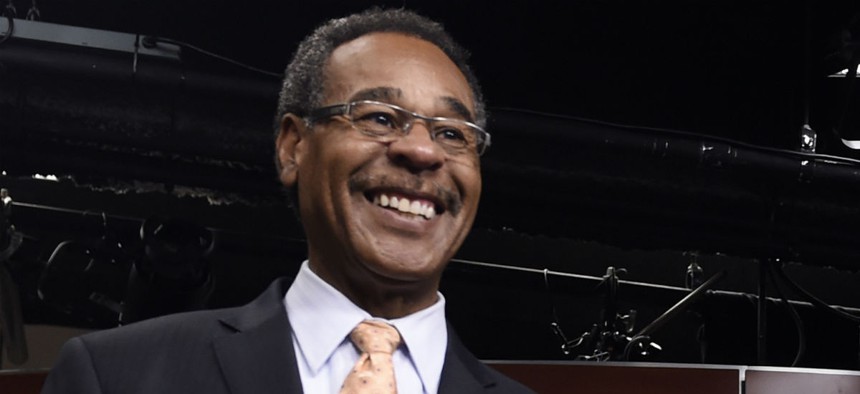
Rep. Emanuel Cleaver II, D-Mo., who helped shepherd the World War I Centennial Commission's creation through Congress. Susan Walsh/AP file photo
D.C. World War I Memorial Design to Honor Common Soldier
Concept for adaptation of Pershing Park might still be tweaked by agencies.
The congressionally mandated campaign to add a World War I memorial to the Washington landscape took a major step on Tuesday with the announcement of a winner in its open and international design concept contest.
Seeking to remedy a perceived neglect of “the Great War” and the average service members who “did the dying,” the U.S. World War I Centennial Commission voted 8-1 to select from five finalists a concept titled “The Weight of Sacrifice.”
It was created by a 25-year-old Arkansan architect in training named Joseph Weishaar. He in turn teamed up with veteran New York –based sculptor Sabin Howard to create images of soldiers to be incorporated in a design that creates a “sense of inclusion but is inviting and visible,” said commission vice chairman Edwin Fountain at the design concept’s unveiling at the National Press Club.
Pershing Park, located at 14th and Pennsylvania Ave. Northwest in a heavily trafficked area a block from the White House, honors the top commander of the American Expeditionary Forces sent to fight in Europe 99 years ago. But Pershing was a “soldier’s general who believed generals got too much attention,” said his granddaughter-in-law, Sandra Pershing, who spoke surrounded by two living history actors in restored but genuine doughboy uniforms.
The chief defect of the current park’s design, said Fountain, is that it is “not visible and accessible.” The winning design concept “respects the existing design of the park” while contributing to the ambience of adjacent sites, such as the Willard Hotel, the Treasury Department and the Sherman Memorial, he said.
The consensus on the commission is that World War I—which mobilized 4.7 million U.S. troops and caused 116,000 deaths mostly in the final six months—has been “left out of national consciousness and therefore national discussion,” said commissioner Libby O’Connell. “Yet much of the way our country is organized economically, socially, politically is because of World War I,” she added, mentioning advances in aviation technology, the suffragists and the United States “beginning to see itself as a positive agent of change in the world.”
The war’s shadow, she said, remains cast over today’s fighting in Iraq and Syria, where locals still debate the borders imposed by the 1916 Sykes-Picot line. “So little tribute in the national capital area,” she warned, might make current living warfighters and veterans worry that “their service will not be remembered.”
Fountain added that his commission’s project differs from the World War II, Korean War and Vietnam War memorials on the now-filled National Mall in that the others were created with support from living veterans.
Though some critics have pointed out that World War I memorials already exist around the country (including one in the District of Columbia off Independence Avenue), Fountain lamented that many have been “hidden in plain sight” and “repurposed” as general war memorials. His group’s education mission targets young people in case “some dumb high school kid learning about World War II figures out that there must have been a World War I.”
The memorial project has been reviewed by the National Park Service, Commission of Fine Arts, the National Capital Planning Commission and District of Columbia Historic Preservation Office, with mixed reactions. The World War I commission has also been working with the National World War I Museum in Kansas City, Mo., and the Pritzker Military Museum and Library in Chicago.
Fountain said the design concept may still undergo changes by the National Capital Planning Commission. He hopes for a final approval by the third quarter of 2016, with a goal of completing construction on the estimated $30 million-$40 million privately funded memorial by Veterans Day 2018.
Present for the design announcement was Rep. Emanuel Cleaver II, D-Mo., who helped shepherd the commission’s creation through Congress. He recalled that when he was elected mayor of Kansas City in 1991, one of his first acts was to raise a sales tax to restore the decaying Liberty Memorial on the site where hundreds of trains came through carrying servicemen to the First World War.
Its 1921 dedication by President Coolidge with the allied leaders in attendance was witnessed by a future President, Harry Truman, said Cleaver, who is working in Congress to get Truman memorialized in Washington as well.
Clarification: This article has been updated to clarify that the National Park Service, Commission of Fine Arts, National Capital Planning Commission and District of Columbia Historic Preservation Office have reviewed the memorial project, but do not necessarily support the final design.







